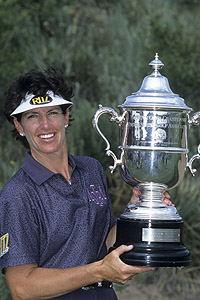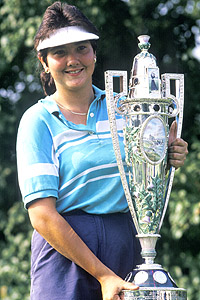This is the second and final story looking at great players from the San Francisco Bay Area. Part II focuses on female standouts, while Part I centered on the best male players to hail from the area, which is hosting the 2012 U.S. Open at The Olympic Club.
If they all find themselves at home in the San Francisco Bay Area at the same time – not a frequent occurrence, given their travel schedules – Juli Inkster, Kay Cockerill and Pat Hurst enjoy getting together for a round of golf.
They might play at Los Altos Golf & Country Club or Pasatiempo Golf Club or The Olympic Club. It’s just a casual round among friends, in some ways, with lively conversation and laughter all around. Then again, a quick count of the USGA titles owned by the group illustrates this is anything but a typical threesome.
Inkster has won five USGA championships (three U.S. Women’s Amateurs and two U.S. Women’s Opens), while Cockerill (two Women’s Amateurs) and Hurst (one U.S. Girls’ Junior and one Women’s Amateur) each own two. That’s nine USGA national championships in all – a tidy snapshot of the Bay Area’s tradition of producing great female golfers.
Just as many distinguished male players grew up in the region, highlighted by Johnny Miller and Ken Venturi, several females also used Bay Area courses as a springboard to success. Start with Inkster, Cockerill and Hurst, but don’t forget Paula Creamer of Pleasanton (nine LPGA Tour wins, including the 2010 U.S. Women’s Open), Dorothy Delasin of South San Francisco (four LPGA victories, plus one Women’s Amateur and one Girls’ Junior), Christina Kim of San Jose (two LPGA wins) and Dana (Lofland) Dormann of Pleasanton (two LPGA victories, plus one Girls’ Junior).
This rich history offers a nice backdrop to this year’s U.S. Girls’ Junior, scheduled for July 16-21 at Lake Merced Golf Club in Daly City, Calif. Lake Merced is a tight, tree-lined layout right down the road from The Olympic Club, with its own long tradition of hosting USGA events (including a U.S. Open sectional qualifier on June 4 and the 1990 U.S. Junior Amateur).
It also provides a daunting challenge, like many other Bay Area courses – which begins to explain the abundance of accomplished female players from the area. Inkster launched her journey to the World Golf Hall of Fame in her hometown of Santa Cruz, where she learned the game at Pasatiempo, a classic and stout Alister Mackenzie gem which hosted the 1986 Women’s Amateur (won by Cockerill) and the 2004 USGA Senior Women’s Amateur (won by Carolyn Creekmore).
 |
 |
|
| 5-time USGA champ Juli Inkster | 2-time USGA champ Pat Hurst |
“It actually took me a while to learn how to play less difficult courses. All of a sudden you go to Florida and you can hit all the par 5s in two shots, and they don’t have ravines or canyons. So I think playing in this area, and playing all these great courses, really shaped my game and got me used to the difficulty.”
Cockerill grew up in Los Gatos, outside San Jose and about 20 minutes from Santa Cruz. She left the Bay Area to attend UCLA – unlike Inkster and Hurst, who played at San Jose State – but she took with her a playing style hatched in Northern California.
“When I see players from NorCal, I think great putters and great short games,” says Cockerill, now a Golf Channel commentator who walked on at UCLA and went on to become an All-American. “We have a lot of older courses without great practice facilities and with a lot of smaller greens. So we were out playing more than we were pounding balls – and we were constantly challenged on the course.”
Cockerill, like many other Bay Area women, found inspiration in Inkster’s success. Cockerill specifically recalls the headlines trumpeting Inkster’s three consecutive U.S. Women’s Amateur titles in 1980, ’81 and ’82, about the time she was starting to become more involved in the game.
Inkster has thrived at every level, from her dominant amateur days to her long and prosperous professional career in which she has won 31 times on the LPGA Tour, including seven major championships.
Those victories – most notably, the 2002 U.S. Women’s Open at age 42 – might have generated more attention, but Inkster holds a special fondness for her streak of U.S. Women’s Amateur wins, which was completed a full 14 years before Tiger Woods pulled off the same three-peat on the men’s side.
Talk all you want about the Bay Area’s challenging courses, and how they prepared Inkster and Co. for elite competition. There also was a fundamental ferocity needed to advance through match play, year after year after year.
“Once it got to match play, it was just me, mano-a-mano, against the other player,” Inkster says. “That fire inside you, that competitiveness of not wanting to lose – that’s what match play is all about, playing each match as its own entity. …
“Winning those Amateurs was great. It opened up so many doors for me, to play in LPGA events as an amateur, the World [Amateur Team Championship], the Curtis Cup. Those were unbelievable experiences. To win 18 matches in a row, it was pretty incredible – that might be my best golfing accomplishment.”
Hurst grew up in San Leandro, near Oakland, and used Northern California Golf Association events to sharpen her game. That’s a common theme among these players, especially in an era before the growth and popularity of the American Junior Golf Association.
| Great Bay Area Female Champions |
| Kay Cockerill (1986, 1987 U.S. Women's Amateur) Pat Cornett (1978, '88 Curtis Cup; 2012 Curtis Cup Captain Paula Creamer (2010 U.S. Women's Open) Dorothy Delasin (1996 U.S. Girls' Jr.; 1999 U.S. Women's Amateur Dana (Lofland) Dormann (1985 U.S. Girls' Junior) Lisa Ferrero (2000 U.S. Girls' Junior) Shelley Hamlin (1968, 1970 Curtis Cup) Pat Hurst (1986 U.S. Girls' Jr.; 1990 U.S. Women's Amateur Juli Inkster (1980-82 U.S. Women's Amateur; 1999 and 2002 U.S. Women's Open |
“We had a great junior golf organization when I was growing up,” Hurst says. “I had a competition every week and played great courses for hardly anything – I’d play places for $5 or $10. …
“We had a lot of great junior golfers at Castlewood. So I’d compete with them day in and day out, or I’d go out there and work on my game. I also played skins games throughout the Bay Area – I totally enjoyed being out there.”
Cockerill, too, traces her success on the national stage to her younger days.
“The NCGA was very instrumental when I was growing up,” she says. “Most of the girls ahead of me played in NCGA events – that’s how we got a lot of competition. California had great junior golf, providing tournaments all summer long or during school vacations. So you could start playing and competing, and that’s when (college) coaches were looking for players.”
Cockerill carries vivid memories of her first U.S. Women’s Amateur victory in 1986, in part because it happened at Pasatiempo, just a short drive from her childhood home. She had played in the two previous Amateurs, reaching match play and steadily building her confidence.
Then she stormed through match play in ’86, taking a 6-up lead through 18 holes on Kathleen McCarthy – whom Cockerill knew from their junior days – in the 36-hole final. So many friends and family came up to congratulate Cockerill during the lunch break, she and her caddie retreated to the Pasatiempo parking lot, found a bench and ate their sandwiches in relative peace, knowing they still had to finish the job.
Cockerill did just that, winning 9 & 7. She won again the next year, at Rhode Island Country Club, to seize a back-to-back slice of USGA lore. Her pro career might not have panned out as she hoped, but Cockerill is proud of her Amateur triumphs.
“Those wins were the highlight of my career,” Cockerill says. “The first one, in front of family and friends, was my first big win nationally. It was a breakthrough moment for me, and it was special in so many ways. I was more confident the next year – I felt like my chances to win were very good. It was more of a surprise the first time.”
All along, Cockerill considered herself part of the Northern California community of women’s golfers. Dormann and Hurst came along a few years later, and eventually the next generation arrived in force – from Delasin to Kim to Creamer, who lived in Pleasanton until she left to attend a Florida golf academy at age 14.
Inkster still counts as the ringleader, the most decorated player and a mentor to nearly all who followed her. She paved the way for aspiring female golfers from the Bay Area, showing them it was possible to prosper at the game’s highest level – and still maintain a family life at home.
“Juli was more of an inspiration when we were younger,” Hurst says. “Now I do a lot of my practicing with her, and she totally helps me out with different things. She’s a veteran, a Hall of Famer – I’ve got to listen to her. We’re really close.”
They’re close enough that they joined Cockerill in attending the San Francisco Giants’ home opener in April. And their friendly rounds of golf do not always cover 18 holes – they’re sometimes “nine and dine,” as Inkster put it with a chuckle.
This social connection is a natural extension of their shared newsContents and careers in golf. They got the ball rolling, launching an impressive parade of fine players to come from the Bay Area.
“It’s a great place to grow up and learn how to play golf,” Inkster says.
Ron Kroichick covers golf for the San Francisco Chronicle.

